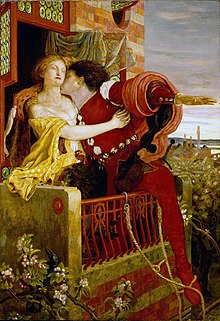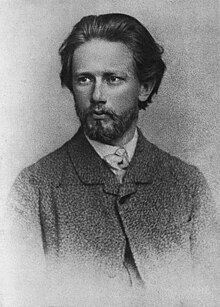Romeo and Juliet (Tchaikovsky)
The action suddenly slows, the key changing from B minor to D-flat (as suggested by Balakirev) and we hear the opening bars of the "love theme", the third strand, passionate and yearning in character but always with an underlying current of anxiety.In the development, the battling strand returns, this time with more intensity and build-up, with the Friar Laurence theme heard with agitation in F♯ minor.Eventually, a fortissimo is reached where the trumpets play an altered Friar Laurence theme with the rest of the orchestra having an off-beat gesture, in B minor.A transition is heard where the clarinets play an altered love theme over restless violin phrases, before the strings enter with a lush, hovering melody over which the flute and oboe eventually soar with the love theme once again, this time loud and in D major, signaling their consummated marriage, and finally heard in E major.The woodwinds play a sweet homage to the lovers, and a final allusion to the love theme brings in the climax, beginning with a huge crescendo B natural roll of the timpani, and the orchestra plays homophonic shouts of a B major chord before the final bar, with full orchestra belting out a powerful B natural to close the overture.Balakirev wrote suggestions about the structure of Romeo and Juliet, giving details of the type of music required in each section, and even opinions on which keys to use.[7] Balakirev had suggested his own overture King Lear as a model for Romeo—a prudent move, since he had seen Tchaikovsky's weakness in writing in an unstructured musical form in Fatum.[8] While basing Romeo and Juliet on King Lear was Balakirev's suggestion, reducing the plot of the former to one central conflict and then combining it with the binary structure of sonata form was Tchaikovsky's idea.[9] In the first version of Romeo and Juliet, the development section contained an opening fugato and a confrontation of the two themes—exactly what an academically trained composer might be expected to produce.The first performance on March 16, 1870, was hindered by a sensational court case surrounding the conductor, Tchaikovsky's friend Nikolai Rubinstein, and a female student.The court had found against the eminent musician the previous day, and this incited a noisy demonstration in his favour when he appeared on the concert platform, which proved much more interesting to the audience than the new overture.[16] According to Tchaikovsky's colleague and friend Sergei Taneyev, who attended the Paris performance, Romeo's lack of success there may have been due to Pasdeloup's failure to understand the music.Balakirev, now having the full score, wrote of their enthusiastic response and 'how delighted everyone is with your D-flat bit [the love theme]—including Vladimir Stasov, who says: "There were five of you: now there are six!"[17] The Overture's love theme has been influentially used in many television series and movies such as Moonraker, Columbo, The Jazz Singer (1927), Wayne's World, Animaniacs, Taz-Mania, Tiny Toon Adventures, Scrubs, Seeing Double, The Simpsons, South Park, Clueless, A Christmas Story, The Fresh Prince of Bel-Air, SpongeBob SquarePants, Pushing Daisies, Sesame Street, El Chavo, The Three Musketeers, and The Ren & Stimpy Show, among others.Excerpts of the overture were played for the fireworks at the opening of APEC China 2014 held in Beijing before the leaders of the Asia-Pacific Economic Cooperation.




orchestral workPyotr Ilyich TchaikovskyShakespeareplay of the same nameBerliozProkofievThe TempestHamletopus numberalternative catalogueoil paintingFord Madox Brownsymphonic poemsonata formF-sharp minorMily BalakirevFriar LaurencechoraleB minorD majorconsummatedcymbalB majortimpanitripletcrescendohomophonicMoscow Conservatoryfirst symphonyNikolai RubinsteinMoscowBalakirevWilliam ShakespeareRomeo and JulietUndineBeethovenfugatoquartetdevelopmentP. JurgensonEduard NápravníkTbilisiGeorgiaMikhail Ippolitov-IvanovHans RichterEduard HanslickJules PasdeloupSergei TaneyevCamille Saint-SaënskuchkaVladimir StasovMoonrakerColumboThe Jazz SingerWayne's WorldAnimaniacsTaz-ManiaTiny Toon AdventuresScrubsSeeing DoubleThe SimpsonsSouth ParkCluelessA Christmas StoryThe Fresh Prince of Bel-AirSpongeBob SquarePantsPushing DaisiesSesame StreetEl ChavoThe Three MusketeersThe Ren & Stimpy ShowThe SimsThe NutcrackerAnna KareninaBoris EifmanLarry ClintonBuddy BernierJimmy DorseyWalter MurphyAPEC China 2014BeijingAsia-Pacific Economic CooperationRandom HouseKamien, RogerArnold J. PomeransInternational Music Score Library ProjectList of compositionsMusical styleSymphoniesThe FiveBelyayev circleThe VoyevodaUndinaThe OprichnikVakula the SmithEugene OneginThe Maid of OrleansMazepa (or Mazeppa)CherevichkiThe EnchantressThe Queen of SpadesIolantaSwan LakeThe Sleeping BeautyNo. 1 in G minorNo. 2 in C minorNo. 3 in D majorNo. 4 in F minorSymphony in B minorNo. 5 in E minorNo. 6 in B minorSymphony in E♭ majorPiano Concerto No. 1 in B♭ minorPiano Concerto No. 2 in G majorPiano Concerto No. 3 in E♭ majorConcert FantasiaAndante and FinaleSérénade mélancoliqueValse-ScherzoViolin Concerto in D majorVariations on a Rococo ThemePezzo capricciosoCello ConcertoCapriccio ItalienFrancesca da RiminiThe Storm